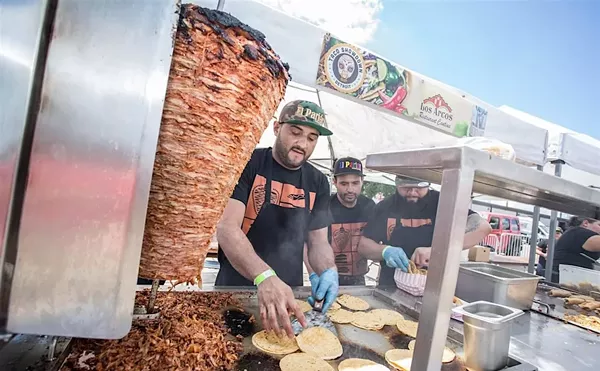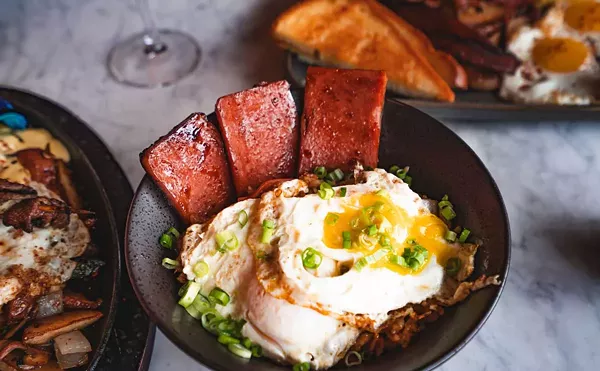Leave the tipping system alone
Living wages for tipped employees paid by already strapped restaurant owners is a bad idea


Audio By Carbonatix
[
{
"name": "GPT - Leaderboard - Inline - Content",
"component": "35519556",
"insertPoint": "5th",
"startingPoint": "3",
"requiredCountToDisplay": "3",
"maxInsertions": 100,
"adList": [
{
"adPreset": "LeaderboardInline"
}
]
}
]
Chowhound is a weekly column about what’s trending in Detroit food culture. Tips: eat@metrotimes.com.
As of April 1 in California, minimum wage for the state’s fast-food workforce increases to $20 an hour. On the East Coast, meanwhile, Empire State legislators are pushing to raise compensation for tipped employees at work in New York City from its current $10-plus rate to $16. While living wage and pay equity hard-chargers applaud this legislation, the restaurant industry finds itself with two more big reasons to wring its hands in worry. As these two major markets go, so may others cross-country, at least where there’s groundswell complaining over sub-standard, working-class compensation not keeping pace with current inflation.
That sounds like pretty much everywhere at present, doesn’t it?
Sure, it only makes sense that this long mulled-over move away from gratuity-reliant income gained the tipping point momentum it needed on both coasts. Servers, bartenders, and such in sunny California and the Big Apple contend with some costs of living that can be exponentially higher than what the vast majority of us ever have to fork over for housing, fuel, and life lived on far less costly real estate. But now, filling an entire country of apartments many hundreds of miles from the Atlantic or Pacific that charge what feels like beach rental rates, economically shell-shocked food and beverage professionals across America are digging in with demands for a greater share of the take from employers who just aren’t raking in the clams like they used to.
With a hard, bi-coastal lean applied by an enormous national food service workforce and its supporters, the toppling of an age-old, tip-centric compensation tradition could follow nationwide. Given all the other economic dominoes currently set on edge across a teetering restaurant industry, one wonders how much of a chain reaction might be set in motion by these two initiatives.
On the consumer side, Californians can and New Yorkers must expect to see significant menu price increases on the heels of these passed and proposed pay hikes. In a February 2023 Business Insider report, Citi analyst Jon Tower felt certain with his projections of across-the-board restaurant inflation ranging anywhere from 5% to low double-digits in these circumstances. Though California’s new wage law targets only fast-food operations specifically, other dining segments are likely to feel pressure to raise wages as well in order to compete for hard-to-find labor, and not only in food service but the retail sector, too, which generally draws from the same job-seeker demographics.
“If we have to address that as part of our overall inflation basket,” Beverly Hills-based Cheesecake Factory CFO Matt Clark speculated during a November 2023 address to shareholders, “we’ll certainly have to consider that with respect to pricing decisions.” Given California alone, with its reputation as a progressive Petri dish, this seismic wage raise may well ripple east across like-minded constituencies of a middle American proletariat. Should a similar wave get rolling west out of Gotham, take a deep breath, because restaurant-going at even remotely similar price points to what we’re willing to swallow now will wash by us just like that.
Then again, on the working man’s end, I see another side to this same old, overworked, underpaid story. Hear me out.
As a one-time waiter and bartender, I see a gaping hole in this living wage boat some think should float today’s food industry workforce. I beg to differ, at least a bit. Thirty years ago, those who plied my trade could regularly expect to earn $20 an hour, minimum, with tips. And that’s a low-end range reflective of what service staff in any fairly busy, average-priced, full-service eatery (breakfast joint, lunch café, family restaurant) could expect to pull in routinely. Higher-end earnings of $30-$40 an hour and up were what finer and fine dining room staff and bartenders raked-in. Since tip commissions have increased along with bottom-line costs of going out over the years, one assumes, despite maybe more than commensurate cost-of-living increases over time, food and beverage professionals might still make good livings at what they can learn to do well, given time to learn, committed effort, and some experience. Go ahead now and call me old school or out of touch for having such a say, but here goes: When I was 20 and just getting started, I waited tables in a coffee shop where I earned $2.13 an hour and maybe $500 more a month in tips. My half of the rent in those days (1983) — utilities included — was $200. After finding somewhere better to live and work about a year later, I started netting $75-$100 a shift at a barbecue place (pre-post-work partying expenses). Though I made my monthly bills in less than a week, all I squandered left me late on rent regularly. Five years in and just married, bartending money followed. By 30, I was earning $40-50k. By 35, I was pushing six figures in a place where I had to know my food and wine well enough to cater to a well-heeled crowd who could afford me that living, along with things like diapers and almost daily dime bags of good weed, clothing, and homes always rented for lack of savings due to expensive drinking and drugging habits that I long excused as occupational hazards. By my bleary-eyed accounting, my restaurant income was insufficient despite the 30% of it I chose to spend on wine, women, and song, as they say. And despite the money spent on all the blow and everything else I blew it on, I do recall bitching about my employers paying me less than minimum wage on paper which, while patently preposterous, was where my head was at when the cash tips went as easy as they came.
Living wages for tipped employees paid by already strapped restaurant owners is a bad idea. Leave the tipping system alone. And if you want to do front-of-house workforces some general good, frequent restaurants that pay-out charged tips only on payday. And never tip in cash. For what it’s worth…
Subscribe to Metro Times newsletters.
Follow us: Google News | NewsBreak | Reddit | Instagram | Facebook | Twitter






